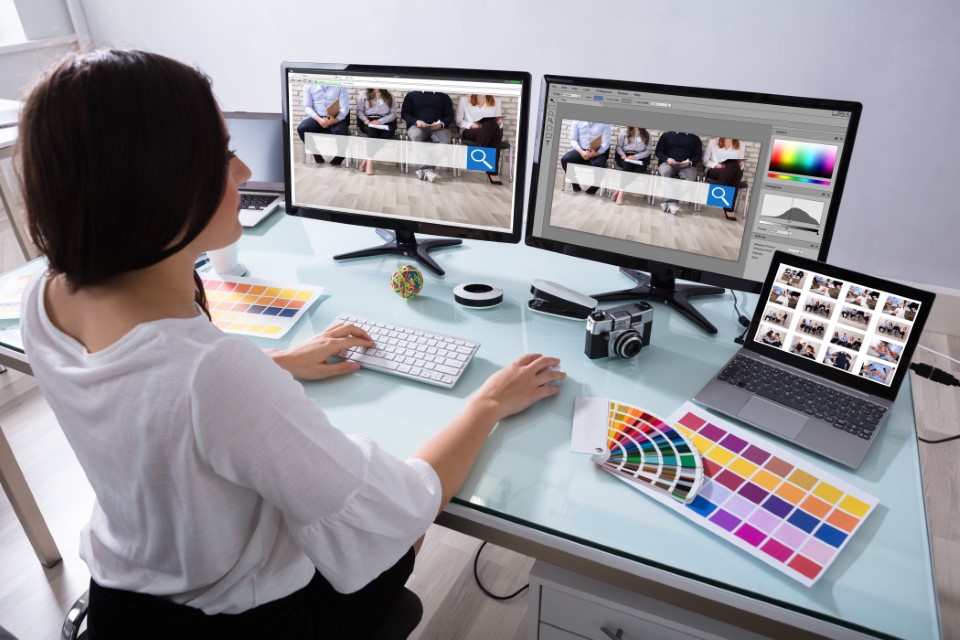
Close-up Of A Female Designer Working On Multiple Computer At Workplace
Graphic designing is a powerful visual communication tool that has taken the world by storm. From logos and brochures to websites and mobile apps, graphic design has become an integral part of our daily lives. But what exactly is graphic designing? In simplest terms, it’s the art of creating visual content to communicate information or ideas through images, typography, and colors.
For businesses, graphic design plays an essential role in building brand identity and recognition. It helps convey the brand’s message effectively while capturing the attention of potential customers. Whether it’s a billboard or social media post, graphics designers work tirelessly to create visually stunning designs that successfully resonate with their target audience.
Introduction:
Graphic design is a visual communication art that uses a combination of images, typography, and colors to convey information or messages to the audience. It could be as simple as designing a business card or as complex as developing an entire branding campaign for a large corporation. The goal of graphic design is to create visually appealing designs that effectively communicate the desired message.
In today’s digital age, graphic design has become an essential part of any business or organization’s marketing strategy. From social media posts to website banners and email newsletters, every aspect of modern marketing requires some form of graphic design. With the increasing demand for visually engaging content, the field has grown rapidly in recent years.
To excel in this competitive industry, designers must possess exceptional creativity and technical skills coupled with strong communication abilities. A successful designer should also stay up-to-date with current trends and technological advancements while remaining true to their personal style and vision. In conclusion, graphic designing plays an integral role in modern marketing practices and requires a unique blend of artistic skills and technical knowledge to achieve success in this highly competitive field.
Graphic design basics
Graphic design is the art of creating visual content to communicate ideas, information, and messages to a specific audience. The practice involves combining text, images, and other design elements to create logos, websites, advertisements, book covers, packaging designs and more. Graphic designers use various tools such as software programs like Adobe Illustrator or Photoshop to create visual pieces that are aesthetically pleasing while also effectively communicating a message.
One of the most important aspects of graphic design is understanding the basic principles of design. These include color theory, typography, composition and layout. Color theory involves using colors that work well together based on their complementary or analogous properties. Typography refers to the selection and arrangement of typefaces in a design piece; this includes choosing fonts that are legible and convey meaning effectively. Composition deals with how elements are arranged within a design piece; this can involve balancing negative space against imagery or placing different elements in strategic positions on a page.
Overall good graphic designing basics ensure that every element works together cohesively for an effective final product. Whether designing for print or digital media platforms mastering graphic designing basics is essential for creating compelling visuals that accurately convey your intended message with your target audience in mind.
Types of graphic design
Graphic design is a creative process that involves combining various elements such as typography, images, and color schemes to create visual content. This type of design can be used for a wide range of projects including logos, websites, brochures, and advertisements. There are several different types of graphic design, each with its unique characteristics.
One popular type of graphic design is branding and identity design. This type of design focuses on creating a consistent image for a company or organization across all mediums including print, digital and social media. Another type is editorial or publication graphic design which relates to designing magazines books and newspapers.
Packaging graphic designs are also significant in creating eye-catching product packaging that stands out on store shelves. These designs play an essential role in attracting potential buyers by communicating the value proposition of the product through imagery and text placement. In conclusion, understanding the various types of graphic designing allows designers to specialize in their area of interest while providing clients with tailored services that meet their specific needs.
Graphic Design is about Molding the User Experience Visually
Graphic designing is the process of creating visual content to communicate information or messages to a specific audience. This content can be in various forms such as logos, advertisements, website designs, packaging and many more. The goal of graphic design is not only to make something look appealing but also to create an experience for the user that effectively conveys a message.
Designers use various elements such as typography, color theory, composition and layout to create visually compelling designs that capture the attention of users. Graphic designers understand that every aspect of design has an impact on how users perceive and interact with their work. The goal is always to achieve a balance between aesthetics and functionality.
In short, graphic design is about creating designs that are both visually pleasing and functionally effective in molding the user experience. It’s about understanding how each element of design plays a crucial role in helping users navigate through visual content easily while conveying important information effectively.
Graphic Design is Emotional Design
Graphic design is the art of visual communication that combines images, typography, and other elements to convey a message to the audience. It plays a critical role in creating an emotional connection between the brand and its customers. In today’s digital age, graphic design has become increasingly important as it helps businesses stand out from their competitors and build a strong brand identity.
Emotional design is an approach that involves designing products or services with the user’s emotions in mind. This technique recognizes that people make decisions based on how they feel rather than just logical reasoning alone. Graphic designers who understand this concept create designs that evoke specific emotions in their audience. For example, they might use warm colors like red and orange to create excitement or blue and green for calmness.
In conclusion, graphic design is not just about creating beautiful visuals; instead, it’s about creating designs that resonate emotionally with the audience. By incorporating emotional design techniques into their work, graphic designers can help brands connect with their customers on a deeper level by eliciting positive emotions such as joy, trustworthiness, excitement, among others.
Common graphic design jobs
Graphic design is the art and practice of creating visual content to communicate information to a specific audience. A graphic designer uses various elements such as images, typography, color, and layout to create a design that can be used for branding, advertising, or other purposes.
One common graphic design job is designing logos. Logos are essential for any company or brand as they represent what the brand stands for and help create brand recognition. A logo designer must create a unique symbol that visually represents the values and mission of the brand. Another common graphic design job is web design. Web designers use their skills to build websites by combining visual elements with coding languages such as HTML, CSS, and JavaScript. They aim at creating visually appealing websites while ensuring optimal functionality.
Lastly, print designers work on designing marketing materials such as posters, brochures, flyers or business cards. Print designers must be skilled in creating designs that not only look good but also effectively convey information about products or services to potential customers through a combination of text and visuals.
Graphic Design Tools
Graphic design is a creative process of visual communication that combines text and images to convey a message to the audience. It is an essential part of marketing, advertising, and branding strategies. Graphic designers use various tools and techniques to create designs that are visually appealing, communicative, and informative.
Some of the popular graphic design tools include Adobe Photoshop, Illustrator, InDesign, CorelDRAW Graphics Suite, Sketch App, Canva Pro, Figma Design Tool. Each tool has its own unique features and capabilities that cater to different design needs. For instance, Adobe Photoshop is ideal for editing photos and creating digital art while Illustrator is used for vector graphics designing.
In conclusion, graphic designing involves myriad skills such as typography selection and layout choice using custom-made illustrations or stock photos. It requires knowledge of color theory to choose the right color palette for specific brands. To be successful in this field one should have good visualization skills along with strong technical proficiency in using these software tools effectively.
Conclusion:
In conclusion, graphic designing is a powerful tool that allows individuals and businesses to communicate their message through visual means. It has evolved tremendously over the years with the help of technology, making it more accessible and versatile than ever before. Whether you’re designing a logo or creating a website layout, there are countless possibilities when it comes to this field. With a little creativity and technical skill, anyone can become a successful graphic designer. So why not explore this exciting world of design today? Start experimenting and see where your imagination takes you!






